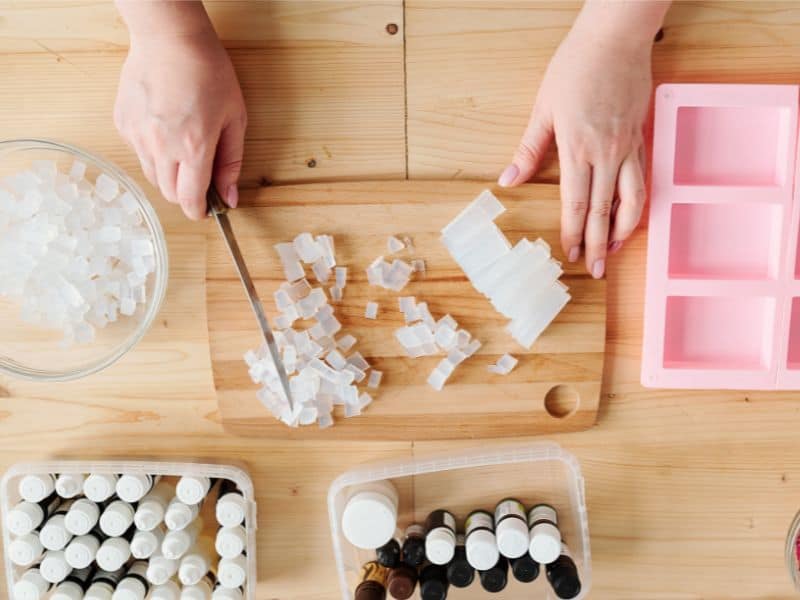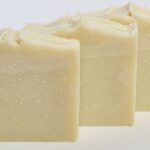If you’re considering taking up soap making, you might wonder whether it’s an expensive hobby to pursue. We are going to explore the costs associated with soap making, including essential and optional supplies, as well as compare homemade ingredients to store-bought alternatives.
Soap making is not an expensive hobby, soap making can be very affordable. It can have some initial expenses, but ongoing costs can be managed with budget-friendly practices. The overall expense depends on individual preferences, chosen equipment, and ingredients.
Like any hobby, soap making can be as expensive or inexpensive as you make it depending on the type and quantity of equipment that you buy. You can start out with soap making kits that are as affordable as $30-$40 or spend hundreds of dollars if that is what you choose.
Let’s take a closer look at expenses related to the soap making hobby.
Cost of Basic Soap Making Supplies
If you’re considering soap making as a hobby, you might be wondering about the cost of basic supplies. In this section, we’ll list the essential items you’ll need and provide estimated costs to help you plan your budget.
Essential Soap Making Items
When starting your soap-making journey, there are some basic supplies you’ll need to create your own soaps:
- Lye (sodium hydroxide)
- Oils (olive, coconut, etc.)
- Distilled water
- Essential oils or fragrance oils
- Colorants (natural or synthetic)
- Mixing container (heat resistant)
- Mixing utensils (spoons, spatulas)
- Protective gear (gloves, goggles)
- Soap mold
Essential Soap Making Cost Estimates
To give you a better idea of the costs involved, here’s a table with estimated prices for each essential soap-making supply:
| Soap Making Supplies | Estimated Cost |
|---|---|
| Lye (sodium hydroxide) | $10 – $15 |
| Oils (olive, coconut, etc.) | $10 – $20 |
| Distilled water | $2 – $5 |
| Essential oils or fragrance oils | $5 – $15 |
| Colorants (natural or synthetic) | $5 – $10 |
| Mixing container (heat resistant) | $5 – $15 |
| Mixing utensils (spoons, spatulas) | $5 – $10 |
| Protective gear (gloves, goggles) | $10 – $20 |
| Soap mold | $10 – $25 |
| Total Cost | $62 – $125 |
Keep in mind that these costs can vary depending on where you purchase your supplies and the quality of the materials.
As you become more experienced, you may choose to invest in higher-quality ingredients or tools, which can also affect the overall cost of your soap-making hobby.
Cost of Optional Soap Making Tools
While the basic supplies are sufficient for making soap, there are optional tools that can enhance your soap-making experience and help you create more intricate designs.
Some of these additional equipment items include:
- Thermometer
- Immersion blender
- Soap cutter
- Silicone molds
- Soap stamp
- Pipettes
- Mica powders
Investing in optional soap-making tools can increase your overall expenses. However, they can also make the process more efficient and enjoyable, as well as add a touch of personalization to your soaps.
Consider your budget and desired level of complexity before purchasing additional equipment.
Optional Soap Making Tool Cost Estimates
Here’s a table with estimated prices for each optional soap-making tool:
| Optional Soap Making Tools | Estimated Cost |
|---|---|
| Thermometer | $5 – $15 |
| Immersion blender | $20 – $50 |
| Soap cutter | $10 – $30 |
| Silicone molds | $10 – $40 |
| Soap stamp | $5 – $20 |
| Pipettes | $3 – $10 |
| Mica powders | $10 – $25 |
Remember, these costs are approximate and can vary depending on the quality and where you purchase the tools. Consider your needs and budget when deciding whether to invest in these optional soap-making tools.
DIY vs. Buying Supplies
Homemade vs Store-Bought Ingredients
When deciding whether to create your own soap-making ingredients or purchase them from a store, there are a few factors to consider.
Homemade ingredients, such as oils and essential oils, can provide a sense of accomplishment and allow for greater control over the end product.
Additionally, using natural ingredients from your garden or local market can add a personal touch to your soaps.
Store-bought ingredients, on the other hand, are often more convenient and can save time. These ingredients are readily available, pre-measured, and come with specific instructions for use.
They can also offer a wider variety of options, such as fragrances and colorants, compared to what you may be able to create at home.
Cost Differences
In general, making your own ingredients can be more cost-effective, especially if you have access to a garden or can source materials locally.
However, this may require more time and effort. Store-bought ingredients can be more expensive but are often more convenient and accessible.
Saving Money on Soap Making
Budget-friendly tips
- Shop at thrift or second-hand stores: Look for soap-making supplies, such as molds, mixing containers, and utensils, at thrift stores or garage sales to save money. These items can often be found at a fraction of the cost compared to buying new.
- Reuse and repurpose items: Instead of buying new equipment, consider using items you already have in your kitchen, such as measuring cups, spoons, and baking pans.
- Create simple recipes: Choose basic, cost-effective ingredients for your soap recipes, such as olive oil or coconut oil, and avoid expensive additives or exotic oils.
- Make soap in smaller batches: Experimenting with smaller batches allows you to perfect your recipe without wasting a large amount of materials.
Bulk purchasing benefits
- Lower cost per unit: Buying soap-making ingredients in bulk can significantly reduce the cost per unit, as suppliers often provide discounts for larger orders.
- Reduced packaging waste: Bulk purchases often come with less packaging, which is not only better for the environment but also reduces waste and clutter in your soap-making space.
- Fewer trips to the store: By purchasing ingredients in bulk, you’ll save time and money on transportation, as you’ll need to make fewer trips to the store to restock supplies.
Keep in mind that bulk purchasing may not be ideal for perishable ingredients or items with a short shelf life. Carefully consider your needs and storage capacity before deciding to buy in bulk.
The True Cost of Soap Making
To understand the true cost of soap making, consider the various factors that contribute to your overall expenses. These include:
Initial investment
The cost of essential and optional supplies, such as lye, oils, molds, and tools. This may range from $62 to $125 for essential items and can increase with the addition of optional tools.
Ongoing expenses
The cost of replenishing consumable ingredients, such as oils, fragrances, and colorants. This will depend on the frequency and scale of your soap-making projects.
Time investment
The time spent researching, shopping for supplies, creating recipes, and making soap should also be considered when evaluating the true cost of the hobby.
Learning curve
There may be some trial and error in the beginning, which could lead to additional costs. However, these expenses are likely to decrease as you become more experienced and efficient.
Cost Compared to Other Hobbies
When comparing soap making to other hobbies, consider the following factors:
Startup costs
While soap making has a moderate initial investment, other hobbies may require more or less upfront spending. For example, painting may have lower startup costs, while photography could require a more significant investment in equipment.
Ongoing costs
The ongoing expenses for soap making can be managed by using cost-effective ingredients and purchasing in bulk. Other hobbies, such as knitting or woodworking, may have similar or higher ongoing costs, depending on the materials used.
Creative satisfaction
Soap making offers a creative outlet that allows for customization and experimentation with colors, fragrances, and designs. This may be more fulfilling for some individuals compared to hobbies that have less room for personalization.
Practicality
Unlike some hobbies, soap making results in a functional product that can be used daily or given as gifts. This added practicality may increase the overall value of the hobby for some individuals.
While startup costs can be moderate, the ongoing expenses can be managed through cost-effective practices. When compared to other hobbies, soap making offers a unique combination of creativity, practicality, and potential for personalization.
Frequently Asked Questions
Yes, optional tools include a thermometer, immersion blender, soap cutter, silicone molds, soap stamp, pipettes, and mica powders.
Optional tools increase the overall expenses but can make the process more efficient, enjoyable, and add personalization to your soaps.
Shop at thrift or second-hand stores, reuse and repurpose items, create simple recipes, and make soap in smaller batches.
The initial investment, ongoing expenses, time investment, and the learning curve.
Startup costs can be moderate, and ongoing expenses can be managed with cost-effective practices. Soap making offers creativity, practicality, and potential for personalization.
Yes, soap making is suitable for beginners, but it’s essential to learn about the process and safety precautions before starting.
Conclusion
In conclusion, soap making is a versatile and engaging hobby that allows for endless creativity and personalization.
While the initial costs can vary depending on the equipment and ingredients chosen, it’s possible to manage ongoing expenses by adopting budget-friendly practices, such as buying in bulk and repurposing items. Comparing soap making to other hobbies, it stands out for its practical end product and creative satisfaction.
Ultimately, whether soap making is considered an expensive hobby depends on individual preferences and investment choices. By carefully considering your needs, budget, and desired level of complexity, you can create a soap-making experience that’s both enjoyable and affordable.






